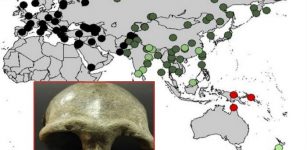Mystery Of The Vittrup Man – Bog Body Of A Foreigner In Neolithic Denmark
Ellen Lloyd - AncientPages.com - The Vittrup Man, a bog body, was unearthed in 1915 in the Northwestern region of Denmark. The remains, which were significantly damaged, were found during a peat-cutting operation along with a wooden club, ceramic vessel, and bovine bones. This Neolithic man was estimated to be between 30 to 40 years old at the time of his death. All evidence points towards him being subjected to ritualistic sacrifice - a prevalent practice in this region during that era.
To the left you can see the cranial remains of Vittrup Man, who ended up in a bog after his skull had been crushed by at least eight heavy blows. Photo: Stephen Freiheit. Image Credit: Fischer et al., 2024, PLOS ONE, CC-BY 4.0. The entire image compilation was made by AncientPages.com
According to Anders Fischer of the University of Gothenburg, Sweden, and his team who studied the bog boy, "the impact lesions on the skull are characterized by oval fractures with larger radiating fracture lines. Such damages are described in the forensic anthropological literature on skeletal traces of fatal violence—e.g., - and are known from other Neolithic human skeletons.
They suggest blunt force caused by contact with an object made of more resilient material than the skull bone, possibly with a rounded surface and a diameter of a minimum of 2 cm. The wooden club found next to the skeletal remains would have been a weapon likely to produce these fractures." 1
Further analysis of his skeletal remains suggested that he lived around 3,300-3,100 BC and was not a local man. Who was this foreigner? Where did he come from, and why had he reached Denmark? These were some of the many questions scientists decided to investigate.
End of life for Vittrup Man. Credit: Anders Fischer (contents) and Niels Bach (drawing), CC-BY 4.0
The isotopes of strontium, carbon, and oxygen found in the tooth enamel of Vittrup Man suggest that his early years were spent on the Scandinavian Peninsula's coast. Genetic analysis further supports this by showing a close link between Vittrup Man and Mesolithic inhabitants from Norway and Sweden. Further analysis of isotopes and proteins in his teeth and bones indicate a dietary shift from coastal food sources such as marine mammals and fish during his early life to farm food, including sheep or goat, during his later years. This transition appears to have occurred during his late teenage years.
The research suggests that Vittrup Man probably spent his early life in a northern hunting and gathering community before relocating to an agricultural society in Denmark. The motives for this move are not entirely clear. Still, researchers suggest that he might have been a trader or captive subsequently integrated into the local population. Despite some unresolved queries surrounding Vittrup Man, this detailed examination of his geographical and dietary past provides new insights into the relationships between European Mesolithic and Neolithic societies.
Everything now breathes peace at the site in the river valley, where the dramatically maltreated
remains of Vittrup Man were deposited in Neolithic times. The peat cut from 1915 has long since been filled in and overgrown. Credit: Anders Fischer
Bog bodies discovered in Scandinavia have been found to originate from significantly distant regions. For instance, research into the bog body Haraldskærkvinnan, found in Denmark, indicates that she had undertaken a long journey just before her demise. Similarly, the Egtved girl's bog body revealed that she was not native to Denmark but originated from an area hundreds of kilometers away from the Egtved region.
The Vittrup Man is a unique genetic foreigner among Neolithic Denmark's population. His lineage aligns closely with Mesolithic individuals from the Scandinavian Peninsula, and there is no substantial evidence of genetic intermingling with Neolithic farmers. Furthermore, he remains the sole individual from Denmark's Funnel Beaker period whose non-local strontium signature has been documented in published research.
"His dietary isotope values indicate that during his teenage years, he switched from a fisher-hunter-gatherer diet to that of a farmer, and during the last many years of life his diet was similar to that of the majority of contemporary individuals found in Denmark. Thus, during his years of maximal physical labor capacity, Vittrup Man lived in a farming society, probably hundreds and possibly more than a thousand kilometers from his childhood home. Many explanations for such a drastic change in life-style and geography are possible, as exemplified in ethnographic and early historic sources.
The refitted fragments of a lugged vase, which was probably deposited in the bog some centuries before the human remains. The rim part is missing. Maximum width 19 cm. Credit: John Lee, Danish National Museum.
He may have been an immigrant or trader who became integrated into equal social standing as other local Funnel Beaker society members. He could also have been a captive/slave providing labor and possibly maritime skills. However, neither his way of death nor his lifestyle allows definite conclusions as to his social standing," the scientists write in their study.
Europe's bog bodies have long fascinated scientists. However, despite rigorous research efforts, it is only now that researchers have comprehensively understood this intriguing bog body phenomenon.
Examinations of bog bodies such as the Vittrup Man, the Haraldskærkvinnan, the Elling Woman, the Egtved girl, and many others provide valuable information about the ancient past.
Written by Ellen Lloyd - AncientPages.com
Copyright © AncientPages.com All rights reserved. This material may not be published, broadcast, rewritten or redistributed in whole or part without the express written permission of AncientPages.com
- Vittrup Man–The life-history of a genetic foreigner in Neolithic Denmark, PLoS ONE (2024). DOI: 10.1371/journal.pone.0297032
Jan Bartek - Mystery Of Europe’s Bog Body Phenomenon Solved By Scientists - AncientPages.com
More From Ancient Pages
-
 Ancient Indigenous Carvings On Boab Trees – Time To Rescue Ancient Art Before Trees Disappear
Archaeology | Oct 12, 2022
Ancient Indigenous Carvings On Boab Trees – Time To Rescue Ancient Art Before Trees Disappear
Archaeology | Oct 12, 2022 -
 Mysterious Leaden Sarcophagus Found Under Notre Dame Will Be Opened
Archaeology | Apr 17, 2022
Mysterious Leaden Sarcophagus Found Under Notre Dame Will Be Opened
Archaeology | Apr 17, 2022 -
 Timing Of Easter Island’s Societal Collapse – Revisited
Archaeology | Feb 7, 2020
Timing Of Easter Island’s Societal Collapse – Revisited
Archaeology | Feb 7, 2020 -
 London’s Oldest Theater Red Lion Discovered Beneath Whitechapel
Archaeology | Jun 10, 2020
London’s Oldest Theater Red Lion Discovered Beneath Whitechapel
Archaeology | Jun 10, 2020 -
 Dendra Armor – 3,500-Year-Old Mycenae Armor Was Suitable For Extended Combat
Archaeology | May 22, 2024
Dendra Armor – 3,500-Year-Old Mycenae Armor Was Suitable For Extended Combat
Archaeology | May 22, 2024 -
 Linked Human Skeletons Lying In Spiral Circle Unearthed In Pre-Aztec Burial Pit Near Mexico City
Archaeology | Feb 7, 2018
Linked Human Skeletons Lying In Spiral Circle Unearthed In Pre-Aztec Burial Pit Near Mexico City
Archaeology | Feb 7, 2018 -
 Legendary Lost Island Of Gold Of The Mysteriously Vanished Srivijaya Civilization Found Underwater
Archaeology | Oct 25, 2021
Legendary Lost Island Of Gold Of The Mysteriously Vanished Srivijaya Civilization Found Underwater
Archaeology | Oct 25, 2021 -
 Rudrama Devi – Warrior Queen Of The Kakatiya Dynasty And First Female Ruler Of South India
Featured Stories | Jul 27, 2021
Rudrama Devi – Warrior Queen Of The Kakatiya Dynasty And First Female Ruler Of South India
Featured Stories | Jul 27, 2021 -
 Cosimo di Giovanni de’ Medici – Exile Of The Generous, Intelligent Banker Caused Fury In Renaissance Florence
Featured Stories | Apr 7, 2021
Cosimo di Giovanni de’ Medici – Exile Of The Generous, Intelligent Banker Caused Fury In Renaissance Florence
Featured Stories | Apr 7, 2021 -
 Denisovan DNA Found In The Genome Of Oldest Human Fossil Discovered In Mongolia
Archaeology | Oct 30, 2020
Denisovan DNA Found In The Genome Of Oldest Human Fossil Discovered In Mongolia
Archaeology | Oct 30, 2020 -
 Ivar The Boneless: Famous Viking And Son Of Ragnar Lodbrok
Featured Stories | Jun 6, 2016
Ivar The Boneless: Famous Viking And Son Of Ragnar Lodbrok
Featured Stories | Jun 6, 2016 -
 ‘Ali Baba Cave’ Treasures: Burial Boxes Inscribed With Jesus’ Name May Help Reconstruct Jesus’ Life And Death
Archaeology | Mar 21, 2017
‘Ali Baba Cave’ Treasures: Burial Boxes Inscribed With Jesus’ Name May Help Reconstruct Jesus’ Life And Death
Archaeology | Mar 21, 2017 -
 Ancient Mystery Of The Unknown White Bearded Rulers
Civilizations | Apr 21, 2020
Ancient Mystery Of The Unknown White Bearded Rulers
Civilizations | Apr 21, 2020 -
 Mysterious Hakkari Stelae: Were They Carved By Inhabitants Of Ancient Kingdom Of Hubushkia?
Artifacts | Nov 15, 2018
Mysterious Hakkari Stelae: Were They Carved By Inhabitants Of Ancient Kingdom Of Hubushkia?
Artifacts | Nov 15, 2018 -
 Opium Residue Discovered In 3,500-Year-Old Pottery Offers Evidence The Drug Was Used In Ancient Burial Rituals
Archaeology | Sep 20, 2022
Opium Residue Discovered In 3,500-Year-Old Pottery Offers Evidence The Drug Was Used In Ancient Burial Rituals
Archaeology | Sep 20, 2022 -
 Scientists Explore How Neanderthals Caught Birds In Caves For Food
Archaeology | Sep 16, 2021
Scientists Explore How Neanderthals Caught Birds In Caves For Food
Archaeology | Sep 16, 2021 -
 Pergamon – One Of ‘Seven Churches Of Asia’ With Great Library And Sophisticated Water Supply System
Civilizations | Jul 25, 2018
Pergamon – One Of ‘Seven Churches Of Asia’ With Great Library And Sophisticated Water Supply System
Civilizations | Jul 25, 2018 -
 Pulque: Ancient Drink Of The Gods Is Popular Again But It Has Odd Side-Effects
Ancient Traditions And Customs | Jun 29, 2017
Pulque: Ancient Drink Of The Gods Is Popular Again But It Has Odd Side-Effects
Ancient Traditions And Customs | Jun 29, 2017 -
 Evil Spirits And Demons Of Marshes And Swamps In Slavic Folklore
Featured Stories | Nov 16, 2016
Evil Spirits And Demons Of Marshes And Swamps In Slavic Folklore
Featured Stories | Nov 16, 2016 -
 Laocoon – A Trojan Priest Who Offended The Gods And Was Strangled By Sea Serpents
Featured Stories | Nov 15, 2021
Laocoon – A Trojan Priest Who Offended The Gods And Was Strangled By Sea Serpents
Featured Stories | Nov 15, 2021




